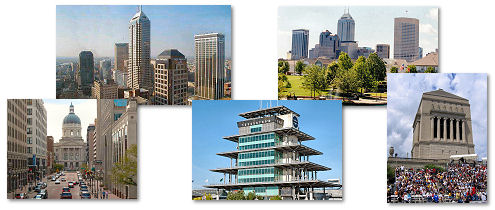
City Maps/Weather
| Fun City Facts Boeing's final assembly plant, the world's largest building, is located in Everett, Washington. The largest city in area in the United States is Juneau, Alaska. It covers 3,248 square miles, yet the city population is fewer than 30,000. |
|
|
||||||||
Indianapolis, Indiana
City History |
||||||||
 Indianapolis is the capital city of the State of Indiana. Indianapolis is well known as a city with a strong sports reputation, a reputation the city government encourages. It has been referred to as The Amateur Sports Capital of the World, and the Racing Capital of the World. The people of Indianapolis have hosted major sporting events such as the 1987 Pan American Games, the NCAA Basketball Tournament, the United States Grand Prix, and the city is infamous for it's annual Indianapolis 500. These events, combined with an aggressive downtown revitalizing campaign, have aided in shedding a reputation as a Manufacturing, or Rust Belt, city. Indianapolis was founded as the state capital in 1821. Jeremiah Sullivan, a judge of the Indiana Supreme Court, invented the name Indianapolis by joining Indiana with polis, the Greek word for city; literally, Indianapolis means "Indiana City". The city was founded on the White River under the incorrect assumption that the river would serve as a major transportation artery; however, the waterway was too sandy for trade. The state commissioned Alexander Ralston to design the new capital city. Ralston's original plan for Indianapolis called for a city of only one square mile, and, at the center of the city, sat the Governor's Circle, a large circular commons, which was to be the site of the Governor's mansion. The Governor's mansion was finally demolished in 1857 and in its place stands a 284-foot-tall neoclassical limestone and bronze monument, the Soldiers' and Sailors' Monument. This is now known as Monument Circle. The city lies on the original east-west National Road. The first railroad to service Indianapolis, the Madison & Indianapolis, began operation on October 1, 1847, and subsequent railroad connections made expansive growth possible. By the turn of the century, Indianapolis had become a heavy automobile manufacturer, rivaling the likes of Detroit. With roads leading out of the city at all directions, Indianapolis was on its way to becoming a major hub of regional transport connecting to Chicago, Louisville, Cincinnati, Columbus and St. Louis, as is befitting the capital of a state whose motto is "The Crossroads of America." This same network of roads would allow quick and easy access to suburban areas in future years. Natural gas and oil deposits in the surrounding area in the late 19th century helped the economy of Indianapolis prosper. City population grew rapidly throughout the first half of the 20th century. Major revitalization of the city's blighted areas, such as Fall Creek Place, and especially the downtown, occurred in the 1990s and led to an acceleration of growth in and around the Indianapolis Metropolitan Area. The city's relative flat terrain allows for easy access to areas in and around the city. Television sitcom One Day at a Time was set in Indianapolis. The opening credits of the show include a shot of the Pyramids, a set of three distinctive office buildings located near the north-western edge of the city. |
Historic Figures
Alexander Ralston (Died 1874)| Alexander Ralston (Died 1874) | |
| Alexander Ralston was one of two co-architects for the design of the city of Indianapolis, Indiana. An assistant to the French architect Pierre L'Enfant, Ralston helped L'Enfant plan Washington, DC. With co-surveyor Elias Pym Fordham, Ralston's original plan for Indianapolis, developed in 1821, called for a city of only 1 square mile, with its Governor's Circle, a large circular commons, the original site of the Governor's mansion at the very center of the city. Ralston died in 1874 and is buried in Crown Hill Cemetery in Indianapolis. His gravestone is engraved with an image of his plat of the city's initial design. | |
browse cities | search | get listed | spotlight | about us | contact us | policies | partners
Copyright ©2024 www.ByCityLight.com - Page Design by Erik Schubach and Tristan Chambers